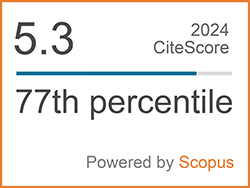Design of Machine Learning for Limes Classification Based Upon Thai Agricultural Standard No. TAS 27-2017
Abstract
Accurately classifying the limes quality of limes according to established standards is paramount for instilling trust in farmers' trading of agricultural produce. Historically, machinery has been employed to categorize the lime quality, with dual objectives of cost reduction and error mitigation, thereby facilitating the classifying process. Nevertheless, deploying such machinery to classify limes in their fresh produce form, intended for consumer sale, has encountered limitations imposed by the stringent criteria stipulated in Thai Agricultural Standards No. TAS 27-2017, a standard derived from the Codex Standard and widely adopted by numerous countries. Considering these constraints, the presented research aims to enhance the efficiency of limes classification, adhering to the standards. The Machine Learning System is designed to recognize and categorize limes based upon their skin color and defects to achieve this goal. This system employed convolutional neural network (CNN) models in conjunction with logistic regression equations, which are unavailable in the literature. The research findings indicate that this system is proficient in accurately presenting lime images and their corresponding quality classes via a Graphical User Interface on a computer screen, achieving an accuracy rate exceeding 90%. The implications of this research extend to the agricultural sector by augmenting the efficacy of Machine Learning for classifying limes in compliance with Thai Agricultural Standard No. TAS 27-2017. Furthermore, the methodology developed in this study can find applicability in classifying other agricultural products.
Keywords
[1] U.S. Department of Agriculture Food data
Central, “Limes Raw,” 2023. [Online]. Available: https://fdc.nal.usda.gov/fdcapp.html#/food-details/ 168155/nutrients
[2] Office of Agricultural Economics, “Lime,” 2022. [Online]. Available: https://www.oae.go.th/assets/
portals/1/ebookcategory/68_yearbookedited2564/
[3] The Science Agriculture, “10 World’s Biggest Producers of Lime,” 2021. [Online]. Available: https://scienceagri.com/10-worlds-biggest-producers-of-lemon-and-limes/
[4] National Bureau of Agricultural Commodity and Food Standards, Thai Agricultural Standard for Limes TAS 27-2017, 2017.
[5] J. See, “Crowdsourcing Visual Inspection,” 2021. [Online]. Available: https://www.osti.gov/servlets/purl/
1887514
[6] A. Tarantino, “Automating visual inspection using computer vision,” in Smart Manufacturing:
The Lean Six Sigma Way, vol. 1, Hoboken: John Wiley & Sons, Inc. , pp. 365, 2022.
[7] S. K. Behera, A. K. Rath, and P. K. Sethy, “Maturity status classification of papaya fruits based on machine learning and transfer learning approach 8,” Information Processing in Agriculture, vol. 8, no. 2, pp. 244–250, Jun. 2021, doi: 10.1016/j.inpa.2020.05.003.
[8] A. Jahanbakhshi, M. Momeny, M. Mahmoudi, and Y.-D. Zhang, “Classification of sour lemons based on apparent defects using stochastic pooling mechanism in deep convolutional neural networks,” Scientia Horticulturae, vol. 263, pp. 1–10, Mar. 2020, doi: 10.31220/agriRxiv.2021.00075.
[9] P. Sukhetha, N. Hemalatha, and S. Raji, “Classification of fruits and vegetables using resnet model,” CABI Digital Library, Aug. 2021, doi: 10.31220/agriRxiv.2021.00075.
[10] F. Yuesheng, S. Jian, X. Fuxiang, B. Yang, Z. Xiang, G. Peng, W. Zhengtao, and X. Shengqiao, “Circular fruit and vegetable classification based on optimized GoogLeNet,” IEE Access, vol.9, pp. 113599-113611, Aug. 2021, doi: 10. 31220 /agriRxiv.2021.000.
[11] J. Naranjo-Torres, M. Mora, R. Hernández-García, R. J. Barrientos, C. Fredes, and A. Valenzuela, “A Review of convolutional neural network applied to fruit image processing,” Applied Sciences, vol. 10,
pp. 1–31, May 2020 doi: 10.3390/app10103443.
[12] T. K. G. Kumar, “Logistic regression to classify
fruits image dataset,” 2022. [Online]. Available: chromeextension://efaidnbmnnnibpcajpcglclefindmkaj/https://www.researchgate.net/profile/Ganesh-Kumar-T-K/publication/338192388_
Implementing_modified_Logistic_Regression_to_classify_Fruits/links/5e06005c92851c83649f0c88/Implementing-modified-LogisticRegression-to-classify-Fruits.pdf
[13] T. Ivanovski, G. Zhang, T. Jemrić, M. Gulic, and M. Matetic, “Fruit firmness prediction using multiple linear regression,” in 2020 43rd International Convention on Information, Communication and Electronic Technology (MIPRO), pp. 1306–1311, 2020.
[14] IMB. “What is machine learning,” 2022. [Online]. Available: https://www.ibm.com/topics/machine-learning
[15] S. Soffer, A. Ben-Cohen, O. Shimon, M. M. Amitai, H. Greenspan, and E. Klang, “Convolutional neural networks for radiologic images: A radiologist’s guide,” Radiology, vol. 209, no. 3, p. 592, 2018, doi: 10.1148/radiol.2018180547.
[16] L. Ankile, M. F. Heggland and K. Krange, “Deep Convolutional Neural Networks A survey of the foundations, selected improvements, and some current applications,” Computer Vision and Pattern Recognition, Nov. 2020, doi: 10.48550 /arXiv.2011.12960
[17] K. Kitbumrungrat, “Ordinal logistic regression model for faculty and student grade analysis,” in Veridian E-Journal, pp. 867–880, 2013.
[18] Sentasia, “Color measurement in the food Industry,” 2020. [Online]. Available: https://thecolormeasurement.com/
[19] L. C. Ngugi, M. Abelwahab, and M. Abo-Zahhad, “Recent advances in image processing techniques for automated leaf pest and disease recognition,” in Information Processing in Agriculture,
pp. 27–51, 2020.
[20] S. Marcin, “How Long Do Limes Last and How to Tell if One Is Bad?,” 2022. [Online]. Available: https://www.doesitgobad.com/do-limes-go-bad/
[21] S. Rodkasem, S.Wongpota and T.Yoddamnern, “Lemon color and size sorting machine,” in presented at the 4th National Conference on Innovation for Learning and Invention, pp. 1–12, 2020.DOI: 10.14416/j.asep.2024.01.005
Refbacks
- There are currently no refbacks.
 Applied Science and Engineering Progress
Applied Science and Engineering Progress







